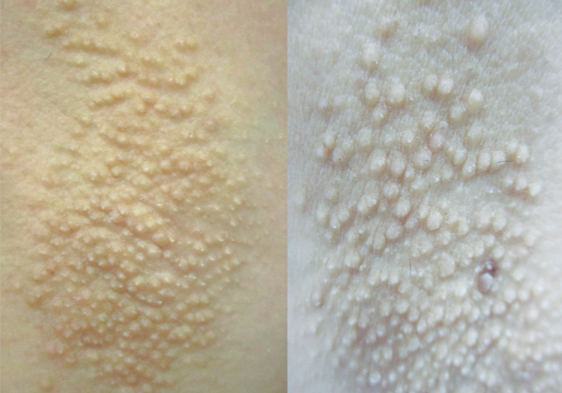Fox-Fordyce disease after laser therapy:
Radiofrequency as a treatment option.
DOI:
https://doi.org/10.29176/2590843X.29Keywords:
Fox-Fordyce disease, lasers, radio wavesAbstract
Apocrine miliaria, also known as Fox-Fordyce disease, is an unusual pathology, characterized by pruritic skin lesions caused by the obstruction of apocrine ducts.
We present and discuss a case secondary to laser therapy and show the successful results of radiofrequency ablation as a therapeutic option.
Author Biographies
Alejandra Ávila-Álvarez, Universidad Pontificia Bolivariana, Medellín, Colombia
Médica, residente de Dermatología, Universidad Pontificia Bolivariana, Medellín, Colombia
María Elizabeth Gaviria-Barrera, Universidad Pontificia Bolivariana, Medellín, Colombia
Médica dermatóloga; docente titular, Universidad Pontificia Bolivariana, Medellín, Colombia
Camilo Arias-Rodríguez, Universidad Pontificia Bolivariana, Medellín, Colombia
Médico interno, Universidad Pontificia Bolivariana, Medellín, Colombia
Luz Marina Gómez, Clínica Universitaria Bolivariana, Medellín, Colombia
Médica dermatóloga, Clínica Universitaria Bolivariana, Medellín, Colombia
References
Helm TN, Chen PW. Fox-Fordyce disease. Cutis. 2002;69:335-42.
Shackelton J, English JC 3rd. Fox-Fordyce disease (apocrine miliaria). J Pediatr Adolesc Gynecol. 2011;24:108-9.
https://doi.org/10.1016/j.jpag.2011.03.005
Bernad I, Gil P, Lera JM, Giménez-de Azcárate A, Irarrazával I, Idoate MA. Fox-Fordyce disease as a secondary effect of laser hair removal. J Cosmet Laser Ther. 2014;16:141-3.
https://doi.org/10.3109/14764172.2013.854630
Tetzlaff MT, Evans K, DeHoratius DM, Weiss R, Cotsarelis G, Elenitsas R. Fox-Fordyce disease following axillary laser hair removal. Arch Dermatol. 2011;147:573-6.
https://doi.org/10.1001/archdermatol.2011.103
Shelley WB, Levy EJ. Apocrine sweat retention in man. II. Fox-Fordyce disease (apocrine miliaria). AMA Arch Derm. 1956;73:38.
https://doi.org/10.1001/archderm.1956.01550010040004
Sammour R, Nasser S, Debahy N, El Habr C. FoxFordyce disease: An under-diagnosed adverse event of laser hair removal? J Eur Acad Dermatol Venereol. 2016; 30(9): 1578-82.
https://doi.org/10.1111/jdv.13680
Helou J, Maatouk I, Moutran R, Obeid G. FoxFordyce-like disease following laser hair removal appearing on all treated areas. Lasers Med Sci. 2013;28:1205-7.
https://doi.org/10.1007/s10103-012-1263-4
Yazganoğlu KD, Yazici S, Büyükbabani N, Ozkaya E. Axillary Fox-Fordyce-like disease induced by laser hair removal therapy. J Am Acad Dermatol. 2012;67:e139-40.
https://doi.org/10.1016/j.jaad.2011.11.925
Alés-Fernández M, Ortega-Martínez de Victoria L, García-Fernández de Villalta MJ. Lesions in the axilla after hair removal using intense pulsed light. Fox-Fordyce disease. Actas Dermosifiliogr. 2015;106:61-2.
https://doi.org/10.1016/j.ad.2014.03.005
George A, Bhatia A, Thomas E. Fox-Fordyce disease: A report of 2 cases responding to topical clindamycin. Indian J Dermatol Venereol Leprol. 2015;81:87-8.
How to Cite
Downloads

Downloads
Published
How to Cite
Issue
Section
License
Copyright (c) 2018 Revista de la Asociación Colombiana de Dermatología y Cirugía Dermatológica

This work is licensed under a Creative Commons Attribution-NonCommercial-ShareAlike 4.0 International License.

| Article metrics | |
|---|---|
| Abstract views | |
| Galley vies | |
| PDF Views | |
| HTML views | |
| Other views | |






